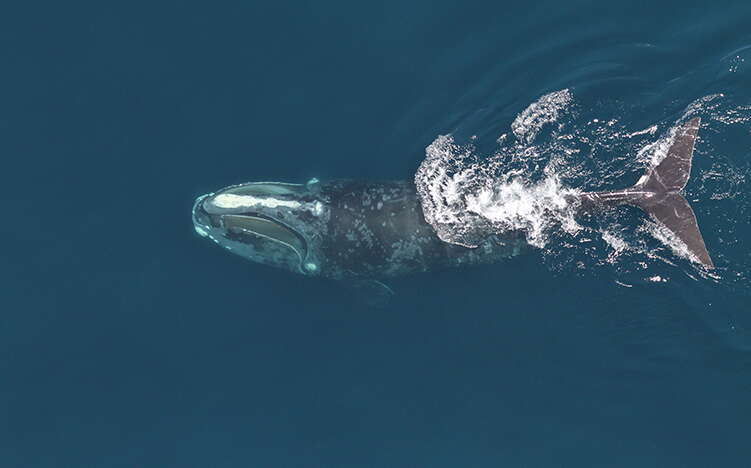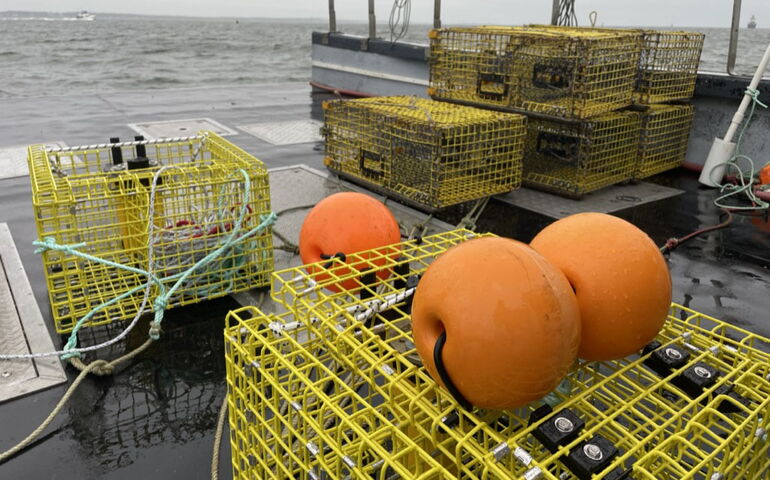
Processing Your Payment
Please do not leave this page until complete. This can take a few moments.
- News
-
Editions
View Digital Editions
Biweekly Issues
- December 1, 2025
- Nov. 17, 2025
- November 03, 2025
- October 20, 2025
- October 6, 2025
- September 22, 2025
- + More
Special Editions
- Lists
- Viewpoints
-
Our Events
Event Info
Award Honorees
- Calendar
- Biz Marketplace
Lobstermen watch for progress as feds invest $9M to help endangered right whales
 Photo / Courtesy, NOAA Fisheries
Lobster traps are outfitted with on-demand systems made by Massachusetts underwater technology firm EdgeTech. The system uses acoustic release technology and a range responder to help relocate trawls and cages, according to its website.
Photo / Courtesy, NOAA Fisheries
Lobster traps are outfitted with on-demand systems made by Massachusetts underwater technology firm EdgeTech. The system uses acoustic release technology and a range responder to help relocate trawls and cages, according to its website.
In its ongoing effort to protect the endangered North Atlantic right whale, the federal government said this week it will invest another $9 million to improve fishing gear and population monitoring.
Investments made last year toward that effort include $82 million for technologies that aim to reduce the risk of vessel strikes, increase the use of on-demand fishing gear and improve enforcement of existing federal regulations.
Another $17.2 million was allocated to the Maine Department of Marine Resources to help improve data collection on the endangered North Atlantic right whale, in a study overseen by the National Oceanic and Atmospheric Administration and administered through the Atlantic States Marine Fisheries Commission.
This week’s round of funding was announced by NOAA’s National Marine Fisheries Service to support collaborations with state agencies, academic institutions, nonprofits and science groups.
North Atlantic right whales are one of the world's most at-risk species, approaching extinction. Threats include entanglement in fishing gear, vessel strikes and climate change, according to a news release.
Of the $9 million, an estimated $6.9 million will support development of on-demand, or "ropeless," fishing gear. The money will allow fishing industry partners to assess the technology's potential for reducing entanglements.
Over 85% of right whales have gotten tangled in fishing gear at least once in their lifetimes, according to NOAA.

Approximately $2.8 million will fund partner efforts to improve monitoring and modeling efforts. Long-term population monitoring is expected to provide insights into individual health and reproduction, as well as distribution, abundance and habitat-use patterns.
Tech partners
None of the money is going to Maine organizations. But Maine is home to the nation’s largest lobster fishery. And the Maine Lobstermen’s Association has said that better data and additional resources could “replace the government’s overly pessimistic assumptions” and provide a more accurate assessment of the fishery’s risk to the whale.
In North Carolina, Duke University’s Marine Geospatial Ecology Lab will receive $1.3 million to build a near real-time modeling system for the whale, which could help predict right whale distribution along the East Coast. Marine Ecology and Telemetry Research, a Washington nonprofit, will receive $796,000 to develop a new generation of miniaturized satellite tags, which could help address questions about right whale distribution and movements.
The Flammang Lab at the New Jersey Institute of Technology is slated for $680,000 to advance tag attachment technology, developing a non-invasive tagging attachment mechanism based on the way other marine life attaches to whales.
The Atlantic States Marine Fisheries Commission, in Arlington, Va., an interstate body that manages shared fishery resources, will receive $7 million to coordinate with fishing industry partners to test the feasibility of removing vertical lines in fixed gear fishing to reduce large whale entanglements.
Ropeless gear tests
With the help of the industry, on-demand gear continues to be developed and refined. Traditional lobster fishing tethers traps on the ocean bottom to ropes attached to buoys at the water’s surface. The main characteristic of on-demand gear is that it does not need this gear-to-buoy tether.
Alternatives being tested include:
- A pop-up buoy: The vertical line is coiled in a cage that is on the ocean bottom attached to a string of traps. When a signal is received from the boat at the surface, the buoy or cage top is released from the cage. The line uncoils to the surface, allowing the fishing vessel to retrieve the gear.
- Inflatable lift bag: A deflated lift bag is attached to a cage connected to a string of lobster traps. When a signal is sent from the boat, the lift bag inflates and the cage rises to the surface. This allows the fisherman to retrieve the cage and the pots that are connected to it.
- Buoyant spool: Line wrapped around a buoyant spool is tethered to a weight on the bottom. When a signal is sent from the boat, the spool is released. As the spool ascends to the surface, the line unwinds from the spool. It rises to the surface where the fishing vessel can retrieve it, and the gear on the string.
The alternative gear is available for fishermen to test, through a gear library that houses dozens of on-demand systems from many different manufacturers, according to NOAA.
Permitted fishermen and researchers can borrow from the library to test gear in real fishing situations. In return, the borrowers provide insights into how the gear operates on their vessel, any problems encountered and suggestions for improving the technologies.
As of mid-2024, NOAA is working with approximately 50 fishermen across five states and three fisheries to test on-demand fishing gear in federal waters that are otherwise seasonally closed to fishing with static vertical lines.
Outside of the closed experimental fishing area, fishermen are testing on-demand systems throughout the year.
As the lobster industry looks to reduce danger to right whales, their decline may be slowing, according to a report last fall by the Northeast Fisheries Science Center, a division of NOAA.
But it’s too early to know whether the slow-down signals that recovery of the population has started.
And the critically endangered species still faces significant ongoing threats from human activities, said the Boston-based New England Aquarium, which participates in a consortium of groups that tracks the animal.
Mainebiz web partners

The Giving Guide
The Giving Guide helps nonprofits have the opportunity to showcase and differentiate their organizations so that businesses better understand how they can contribute to a nonprofit’s mission and work.
Learn More
Work for ME
Work for ME is a workforce development tool to help Maine’s employers target Maine’s emerging workforce. Work for ME highlights each industry, its impact on Maine’s economy, the jobs available to entry-level workers, the training and education needed to get a career started.
Learn More
Groundbreaking Maine
Whether you’re a developer, financer, architect, or industry enthusiast, Groundbreaking Maine is crafted to be your go-to source for valuable insights in Maine’s real estate and construction community.
Learn more-
The Giving Guide
The Giving Guide helps nonprofits have the opportunity to showcase and differentiate their organizations so that businesses better understand how they can contribute to a nonprofit’s mission and work.
-
Work for ME
Work for ME is a workforce development tool to help Maine’s employers target Maine’s emerging workforce. Work for ME highlights each industry, its impact on Maine’s economy, the jobs available to entry-level workers, the training and education needed to get a career started.
-
Groundbreaking Maine
Whether you’re a developer, financer, architect, or industry enthusiast, Groundbreaking Maine is crafted to be your go-to source for valuable insights in Maine’s real estate and construction community.
ABOUT
NEW ENGLAND BUSINESS MEDIA SITES
No articles left
Get access now
In order to use this feature, we need some information from you. You can also login or register for a free account.
By clicking submit you are agreeing to our cookie usage and Privacy Policy
Already have an account? Login
Already have an account? Login
Want to create an account? Register
Get access now
In order to use this feature, we need some information from you. You can also login or register for a free account.
By clicking submit you are agreeing to our cookie usage and Privacy Policy
Already have an account? Login
Already have an account? Login
Want to create an account? Register







0 Comments